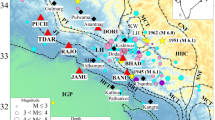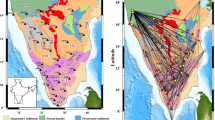Abstract
We examine the influence of attenuation and site on the spectra of microearthquakes having origin within the Shillong region. The ratios of spectral amplitudes at lower and higher frequencies are measured for three different stations at varying epicentral distances to estimate Q value for both P- and S-wave in near and sub-surface layer. The average estimates of Q P and Q S are found to be 178 and 195. The ratio of Q S to Q P emerges to be greater than unity in major parts of the Shillong area, suggesting dominance of dry crust prevailing in Shillong region. The variation in corner frequencies for these spectra is inferred to be characteristics of the site. Besides, the disparity in spectral content with reference to hard rock site yields the inference that the incoming seismic signals get amplified considerably while traversing from southern part to northeastern part of Shillong, best outlined at 2 to 5 Hz, which is well corroborated by the existing lithology.
Similar content being viewed by others
References
Baruah, S., D. Hazarika, N.K. Gogoi, and P.S. Raju (2007), The effects of attenuation and site on the spectra of microearthquakes in the Jubilee Hills region of Hyderabad, India, J. Earth Sys. Sci. 116,1, 37–47, DOI: 10.1007/s12040-007-0005-7.
Bhattacharya, P.M., J. Pujol, R.K. Mazumdar, and J.R. Kayal (2005), Relocation of earthquakes in the Northeast India region using joint hypocenter determination method, Curr. Sci. 89,8, 1404–1413.
Bilham, R., and P. England (2001), Plateau ‘pop-up’ in the great 1897 Assam earthquake, Nature 410,6830, 806–809, DOI: 10.1038/35071057.
Chattopadhaya, N., and S. Hashimi (1984), The Sung valley alkaline ultramaffic carbonatite complex, East Khasi Hills district, Meghalaya, Rec. Geol. Surv. India 113, 24–33.
Cranswick, E. (1988), The information content of high-frequency seismograms and the near-surface geologic structure of “hard rock” recording sites, Pure Appl. Geophys. 128,1–2, 333–363, DOI: 10.1007/BF01772604.
Frankel, A. (1982), The effects of attenuation and site response on the spectra of microearthquakes in the northeastern Caribbean, Bull. Seismol. Soc. Am. 72,4, 1379–1402.
Gupta, H.K., and V.P. Singh (1980), Teleseismic P-wave residual investigations at Shillong, India, Tectonophysics 66,4, 19–27, DOI: 10.1016/0040-1951(80)90246-2.
Kayal, J.R., S.S. Arefiev, S. Baruah, R. Tatevossian, N. Gogoi, M. Sanoujam, J.L. Gautam, D. Hazarika, and D. Borah (2010), The 2009 Bhutan and Assam felt earthquakes (Mw 6.3 and 5.1) at the Kopili fault in the northeast Himalaya region, Geomat. Nat. Hazards Risk 1,3, 273–281, DOI: 10.1080/19475705.2010.486561.
Khattri, K.N., R. Chander, S. Mukhopadhyay, V. Sriram, and K.N. Khanal (1992), A model of active tectonics in the Shillong massif region. In: A.K. Sinha (ed.), Himalayan Orogen and Global Tectonics, Oxford and IBH, Delhi, 205–222.
Lienert, B.R., E. Berg, and L.N. Frazer (1986), Hypocenter: An earthquake location method using centered, scaled and adaptively damped least squares, Bull. Seismol. Soc. Am. 76,3, 771–783.
Nandy, D.R. (2001), Geodynamics of Northeastern India and the Adjoining Region, ACB Publications, Calcutta.
Oldham, R.D. (1899), Report of the great earthquake of 12th June 1897, Mem. Geol. Surv. India 29, 1–379.
Rautian, T.G., V.I. Khalturin, V.G. Martynov, and P. Molnar (1978), Preliminary analysis of the spectral content of P and S waves from local earthquakes in the Garm, Tadjikistan region, Bull. Seismol. Soc. Am. 68,4, 949–971.
Semnov, A.N. (1969), Variations in travel time of transverse and longitudinal waves before violent earthquakes, Izv. — Phys. Solid Earth 4, 245–248 (in Russian).
Srinivasan, P., S. Sen, and P.C. Bandopadhaya (1996), Study of variation of Paleocene-Eocene sediments in the shield areas of Shillong Plateau, Rec. Geol. Surv. India 129, 77–78.
Steidl, J.H., A.G. Tumarkin, and R.J. Archuleta (1996), What is a reference site?, Bull. Seismol. Soc. Am. 86,6, 1733–1748.
Tsujiura, M. (1966), Frequency analysis of seismic waves, 1, Bull. Earthq. Res. Inst., Tokyo Univ. 44,873-891.
Vassilou, M., C.A. Salvado, and B.R. Tittmann (1982), Seismic attenuation. In: R.S. Carmichael (ed.), CRC Handbook of Physical Properties of Rocks, Vol. 3, CRC Press, Boca Raton.
Author information
Authors and Affiliations
Corresponding author
Rights and permissions
About this article
Cite this article
Biswas, R., Baruah, S. & Bora, D.K. Influence of attenuation and site on microearthquakes’ spectra in Shillong region, of Northeast, India: A case study. Acta Geophys. 61, 886–904 (2013). https://doi.org/10.2478/s11600-013-0129-x
Received:
Revised:
Accepted:
Published:
Issue Date:
DOI: https://doi.org/10.2478/s11600-013-0129-x




